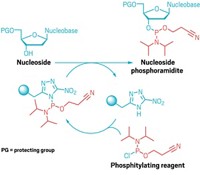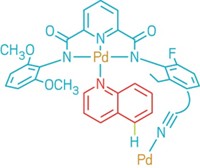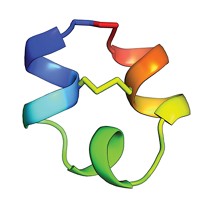Advertisement
Grab your lab coat. Let's get started
Welcome!
Welcome!
Create an account below to get 6 C&EN articles per month, receive newsletters and more - all free.
It seems this is your first time logging in online. Please enter the following information to continue.
As an ACS member you automatically get access to this site. All we need is few more details to create your reading experience.
Not you? Sign in with a different account.
Not you? Sign in with a different account.
ERROR 1
ERROR 1
ERROR 2
ERROR 2
ERROR 2
ERROR 2
ERROR 2
Password and Confirm password must match.
If you have an ACS member number, please enter it here so we can link this account to your membership. (optional)
ERROR 2
ACS values your privacy. By submitting your information, you are gaining access to C&EN and subscribing to our weekly newsletter. We use the information you provide to make your reading experience better, and we will never sell your data to third party members.
Synthesis
Aptamers Aid Analog Synthesis
Organic Chemistry: RNA sequences shelter natural products, easing selective modifications
by Stu Borman
July 26, 2012
| A version of this story appeared in
Volume 90, Issue 31

A new chemical protection scheme using RNA strands could help chemists modify natural products at specific molecular positions and create analogs for drug discovery.
Natural products have inspired the structures of many approved drugs, and medicinal chemists often want to modify them to create analogs with improved drug properties. But in complex molecules with many functional groups, it can be difficult to change one group selectively without making unwanted alterations to others. Selective modifications often require laborious protection and deprotection steps for multiple functional groups.
Graduate students Andreas A. Bastian and Alessio Marcozzi and chemistry professor Andreas Herrmann at the University of Groningen, the Netherlands, have developed a new way to protect multiple functional groups in one shot (Nat. Chem., DOI: 10.1038/nchem.1402).
The new method exploits aptamers, which are RNA sequences that bind targets selectively through noncovalent interactions.
The researchers call the aptamers they use aptameric protective groups (APGs) because they bind and partially enclose natural products, enabling changes at specific molecular positions without affecting other groups.
To demonstrate their method, the researchers used previously identified aptamers for two aminoglycoside natural products, the antibiotics neomycin B and paromomycin. After derivatizing the compounds selectively, the researchers easily removed the APGs by precipitation or hydrolysis to obtain the derivatization products.
The method should be useful for other natural products, according to the researchers. APGs can be selected by immobilizing the natural products on solid supports and screening libraries for aptamers that bind the parts exposed to solution. After the natural products are released from the supports, the previously support-bound parts would be available for modification.
Using aptamers as “noncovalent, supramolecular protecting groups is extremely clever and innovative,” comments University of Bonn aptamer expert Michael Famulok. “The beauty of this approach is that it could be easily employed by standard organic synthesis labs as a strategy that should reduce complex protection and deprotection steps, especially in cases where a molecule contains chemical groups of similar reactivity. If it can be shown that the approach is not restricted to aminoglycosides but can be expanded to other natural compounds, then this new class of protecting groups will likely become a standard in natural compound synthesis.”
University of Florida chemist Weihong Tan says “aptamers can be easily identified and synthesized to bind a wide range of targets, and they form fairly stable complexes. The stability enables controllable modifications,” and the noncovalency of the interactions eases deprotection. He notes that a better understanding of aptamer-target binding would aid extension of the technique to other targets, but APGs “have great potential for modifying natural products.”





Join the conversation
Contact the reporter
Submit a Letter to the Editor for publication
Engage with us on Twitter